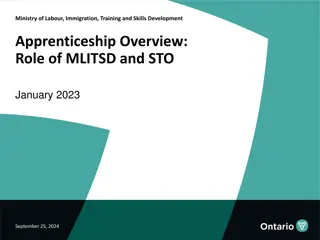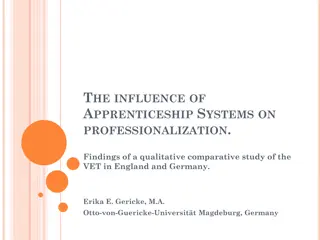Comparative Study of Apprenticeship Systems in England, Finland, and France
This comparative study explores the rhetoric and reality of apprenticeship systems in England, Finland, and France for 16-18 year-olds. It delves into the policy motivations behind researching apprenticeships and examines the roles of employers within these programs. The study also defines apprenticeship, highlights potential employer roles, discusses the policy rhetoric of apprenticeships in England, and presents findings on the multiplicity of policy aims across the three countries. Additionally, it explores the different meanings and pathways of apprenticeship programs in the respective contexts.
Download Presentation

Please find below an Image/Link to download the presentation.
The content on the website is provided AS IS for your information and personal use only. It may not be sold, licensed, or shared on other websites without obtaining consent from the author.If you encounter any issues during the download, it is possible that the publisher has removed the file from their server.
You are allowed to download the files provided on this website for personal or commercial use, subject to the condition that they are used lawfully. All files are the property of their respective owners.
The content on the website is provided AS IS for your information and personal use only. It may not be sold, licensed, or shared on other websites without obtaining consent from the author.
E N D
Presentation Transcript
The rhetoric and the reality of apprenticeship in England: A comparative study of the English, Finnish and French apprenticeship systems for 16-18 year olds Dr Anna Mazenod Anna.Mazenod@gmail.com
Why research apprenticeships? Apprenticeship in policy rhetoric presented as alternative to school-based learning practical vs academic learning Research motivation from policy practitioner experience
Study design Three country cases: England, Finland, France Focus on 16-18 year olds undertaking a formal apprenticeship at any qualification level Systematic literature reviews (research published 1996-2012) and expert interview in each country
Defining apprenticeship Apprenticeship = systematic, long-term training alternating periods at the workplace and in an educational institution or training centre Apprentice is contractually linked to the employer and receives remuneration Employer assumes responsibility for providing training leading to a specific occupation CEDEFOP, 2009 Terminology of European education and training policy
Potential roles for employers within apprenticeship programmes Providers apprenticeship places Part-funders: e.g. apprenticeship tax in France Trainers: in-house training for apprentices Qualification co-developers Advocates: promoting apprenticeships Industry role models: setting standards
Policy rhetoric of apprenticeship in England Employers in the driving seat
Study findings Multiplicity of policy aims for apprenticeship More groundrules for employers in Finland and France, voluntarism in England Employer leadership rhetoric only in England
Meanings of apprenticeship Work-placement type activity for disaffected young people alongside competitive vocational education programmes; training rather than education (England) Traditional pathway for occupations and trades. Also a more recent pathway into higher education (France) One part of a re-integration package for disaffected young people (Finland)
Multiplicity of policy aims Economic and social challenges to which apprenticeship is presented as a solution: 1) improving intermediate vocational skills 2) integrating the worlds of work and education 3) re-engaging disaffected young people
The marginality of apprenticeship Less than 10% of 16-18 year olds are apprentices in England and France, less than 1% in Finland (almost 2/3rds in Germany, Steedman, 2011) Recent growth in England has been concentrated in older age groups, now only 30% of apprenticeship starts are aged 16-18
Can employers be in the driving seat in England? Labyrinthine funding & management systems Prescription is the norm in funding rules Multiplicity of policy aims = apprenticeship as an instrument of government education and training policy (Fuller and Unwin, 2009) Employers are not a homogenous group; the relevance of apprenticeship depends on the occupational sector
Recommendations Develop a consensus around a country-specific coherent meaning of apprenticeship in policy Bridge policy rhetoric with reality of contemporary apprenticeships in England Accept marginality of apprenticeship? Take account of the significance of differences in country contexts in developing policy
References Steedman, H. (2011). The State of Apprenticeship in 2010 - International Comparisons: Australia, Austria, England, France, Germany, Ireland, Sweden and Switzerland. Report to the Apprenticeship Ambassadors Network. Fuller, A. and Unwin, L. (2009). Change and Continuity in Apprenticeship: The Resilience of a Model of Learning . Journal of Education and Work, 22(5), 405-416.























